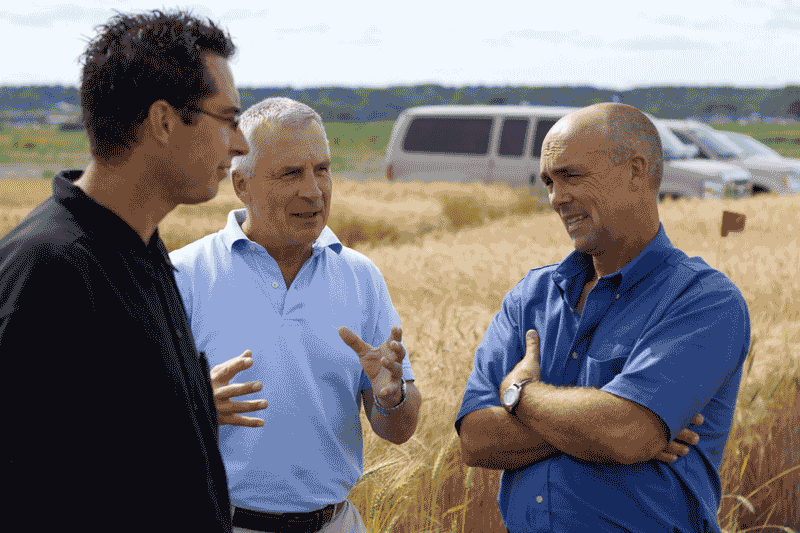Agricultural conversations
THE BENEFITS OF CROP PROTECTION PRODUCTS
when producers speak up about the value of new farming techniques, Canadians will better understand the benefits they provide to everyone.

“Farmers can easily speak to the people around them about the benefits of today’s crop biotechnology and crop protection products,” says Lorne Hepworth, President, CropLife Canada, the trade association representing the manufacturers, developers and distributors of plant science technologies. “For example, the much-improved yield increases and the management of pests and diseases achievable today means they can make a sustainable living from their farms. Used together, these things also allow farmers to practice conservation tillage, which has tremendous environmental benefits.”
What farmers may not have at the ready are concrete numbers relating to the value of being able to use pest control products and new crop genetics – but a report published by CropLife Canada called ‘Cultivating a Vibrant Canada’ may help. The report contains the results from a CropLife Canada study undertaken to examine the impact of the plant science industry on many aspects of life, through comparing conventional agriculture to organic. Concrete numbers in the report demonstrate the benefits.
economics
For example, the whole of Ontario, now struggling with both a huge deficit and debt, benefits greatly economically from the crop protection and plant biotechnology sector – but let’s start at the nation-wide level. The report finds that the use of crop protection and biotech products leads to increased yields and higher-quality crops each year which creates over $6.4 billion worth of off-farm value and $7.9 billion worth of additional economic activity for farmers of field, vegetable and fruit crops. “In addition to increased economic benefits on and off the farm, agriculture also creates over 97,000 full-time jobs nation-wide,” says Hepworth. “At the provincial level, a large portion of this is realized in Ontario – with $1.75 billion in economic spin-offs and over 22,000 jobs across 19 sectors.”
Staying in the economic sphere, the majority – about 65 percent – of Canada’s $10.4 billion net food trade (the value of exported food minus the value of imported food) is due to production efficiencies attained through the use of plant biotechnology and crop protection products. Canadian taxes in the order of almost $385 million annually are generated as a result of the economic activity that stems from crop yield and quality gains, and the subsequent rippling of those gains is realized through the entire economy.
environment
On the environmental front, to produce the same amount of crops we do today without crop protection products and biotechnology, we would need to turn 37 million more acres of land into farmland, which is equal to four times Ontario’s currently cropped land. “Meeting current food production needs without expanding the cultivated land base protects natural spaces and the biodiversity within,” says Hepworth. Pesticides can also play an important role in protecting natural areas and food crops from invasive species of plants, non-native insects and other pests. Food production in Canada would fall by some 40 percent without pest control products, the report shows.
Globally, major crop production has more than tripled since 1960, and Canada now produces enough food to meet its own needs as well as supply more than 150 countries with Canadian crops as well. “With world population rapidly expanding and the amount of arable land for agricultural production decreasing, it’s becoming increasingly important for farmers to produce more on their existing land in a sustainable way,” says Hepworth.
In terms of greenhouse gas emissions, the ability of Canadian farmers to use no-till and conservation tillage because of crop protection and plant biotech products has resulted in a reduction of 12 billion kilograms of carbon dioxide from entering the atmosphere. These reduced tillage and no-till practices are now used on about 72 percent of land currently field-cropped in Canada, and using these methods means fewer passes each year on that land – resulting in 171 million fewer litres of diesel fuel being burned each year.
The availability of crop protection products also means savings for Canadian consumers, with the typical Canadian family saving 58 percent every year on their grocery bill. “Today, Canadians only spend about 10 percent of their income on food, down from 18 percent in the 1960s, and those savings are because of modern tools like pesticides and plant biotechnology that help ensure good yields for farmers,” says Hepworth.
trust
Canadian farmers are the most respected and trusted people to talk about the crops they’re growing and about the economic and environmental value of plant science technologies. “Agriculture is an exciting industry to be in and farmers know this better than anyone,” says Hepworth. “We need to greatly expand the sharing of our stories with Canadians who perhaps don’t fully understand the importance of the technologies that allow us to provide the safe, affordable and high-quality food available at the grocery store.”
To view videos of farmers speaking up about the benefits of crop protection products and plant biotechnology, visit CropLife Canada’s YouTube channel at www.youtube.com/croplifecanada. To read the full report, visit www.croplife.ca. •






















